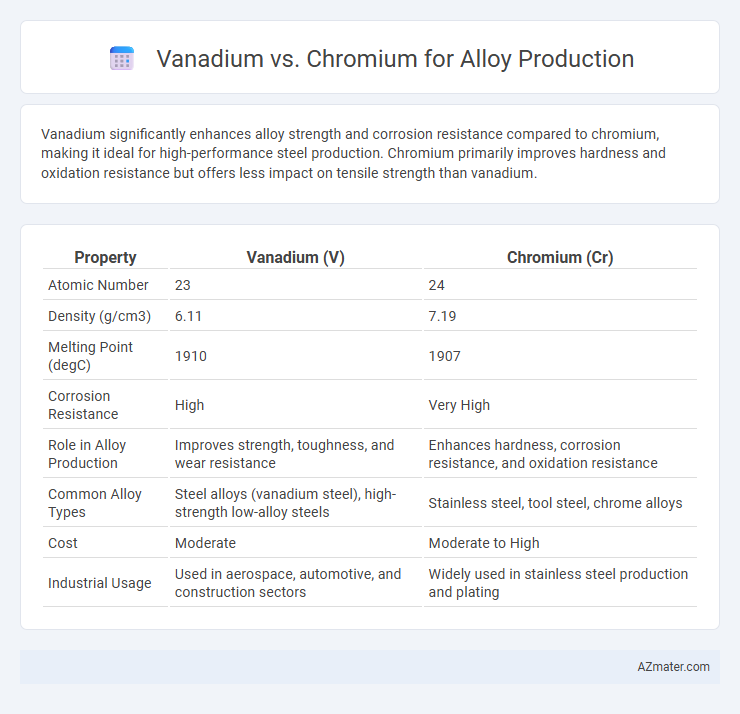Vanadium significantly enhances alloy strength and corrosion resistance compared to chromium, making it ideal for high-performance steel production. Chromium primarily improves hardness and oxidation resistance but offers less impact on tensile strength than vanadium.
Table of Comparison
| Property | Vanadium (V) | Chromium (Cr) |
|---|---|---|
| Atomic Number | 23 | 24 |
| Density (g/cm3) | 6.11 | 7.19 |
| Melting Point (degC) | 1910 | 1907 |
| Corrosion Resistance | High | Very High |
| Role in Alloy Production | Improves strength, toughness, and wear resistance | Enhances hardness, corrosion resistance, and oxidation resistance |
| Common Alloy Types | Steel alloys (vanadium steel), high-strength low-alloy steels | Stainless steel, tool steel, chrome alloys |
| Cost | Moderate | Moderate to High |
| Industrial Usage | Used in aerospace, automotive, and construction sectors | Widely used in stainless steel production and plating |
Introduction to Alloying Elements: Vanadium vs Chromium
Vanadium and chromium are essential alloying elements widely used in steel production to enhance mechanical properties such as strength, hardness, and corrosion resistance. Vanadium primarily improves toughness and fatigue resistance by refining grain structure, while chromium significantly increases hardness and oxidation resistance, making it ideal for stainless steel applications. Their distinct chemical behaviors and effects on microstructure dictate specific alloy formulations tailored to performance requirements in industrial and automotive sectors.
Chemical Properties and Reactivity
Vanadium exhibits a higher resistance to corrosion and oxidation compared to chromium, enhancing its performance in alloy production, especially in high-temperature environments. Chromium's superior hardness and oxidation resistance make it ideal for stainless steel, but it is more reactive with acids and alkalis than vanadium. The difference in chemical reactivity influences alloying behavior, with vanadium providing enhanced toughness and fatigue resistance while chromium contributes increased hardness and corrosion protection.
Effects on Steel Strength and Hardness
Vanadium significantly enhances steel strength and hardness by promoting fine grain structure and forming stable carbides that increase wear resistance and toughness. Chromium contributes primarily to corrosion resistance and surface hardness, improving steel's ability to withstand oxidation and abrasive wear. Combining vanadium and chromium in alloy steel optimizes mechanical properties by balancing superior tensile strength and hardness with enhanced durability and corrosion resistance.
Corrosion Resistance: Vanadium Compared to Chromium
Vanadium enhances corrosion resistance in alloy production by forming stable oxide layers that protect metal surfaces from oxidation and chemical degradation. Chromium is well-known for its ability to create a passive chromium oxide film, which significantly improves rust resistance and durability in harsh environments. While chromium offers superior corrosion protection in stainless steel alloys, vanadium contributes to improved strength and corrosion resistance in high-performance alloys used in aerospace and power generation.
Impact on Wear Resistance and Toughness
Vanadium enhances alloy wear resistance by forming stable carbides that improve hardness and reduce abrasion, making it crucial for high-performance tool steels. Chromium contributes significantly to toughness and corrosion resistance while also increasing wear resistance through the formation of hard chromium carbides. The combination of vanadium and chromium in alloys balances wear resistance and toughness, optimizing durability in demanding industrial applications.
Role in Industrial Alloy Applications
Vanadium enhances alloy strength, toughness, and corrosion resistance, making it essential for high-performance steel and aerospace components. Chromium primarily contributes to hardness, wear resistance, and oxidation protection, crucial in stainless steel and tooling alloys. Both elements play vital roles in industrial alloy applications by improving mechanical properties and durability under extreme conditions.
Cost Considerations and Availability
Vanadium offers cost advantages due to its relative abundance in large deposits, leading to more stable pricing compared to chromium, which faces supply constraints from limited mining regions. The fluctuating availability of chromium, heavily reliant on geopolitical factors and export restrictions, often drives its price volatility, impacting alloy production budgets. Manufacturers weigh vanadium's lower and more predictable costs against chromium's superior corrosion resistance, optimizing alloy formulations based on material availability and economic feasibility.
Environmental and Health Implications
Vanadium and chromium both play crucial roles in alloy production, but their environmental and health implications differ significantly. Vanadium exposure, primarily through dust inhalation, can cause respiratory issues and is less toxic compared to hexavalent chromium, which is a recognized carcinogen associated with severe lung and skin diseases. Proper handling and regulatory measures are essential to minimize occupational hazards and environmental contamination stemming from chromium use, while vanadium demands monitoring to prevent ecological accumulation and toxicity.
Alloy Production Process Differences
Vanadium enhances alloy production by refining grain structure and improving strength through its ability to form stable carbides, which alters the heat treatment process by requiring precise temperature control to avoid carbide coarsening. Chromium in alloy production primarily contributes to corrosion resistance and hardness, with its addition necessitating adjustments in melting and solidification parameters to ensure uniform distribution and prevent segregation. The key difference in alloy production processes lies in vanadium's impact on microstructural refinement and thermal stability, whereas chromium demands careful control over oxidation and alloy homogeneity.
Choosing the Right Element: Vanadium or Chromium?
Vanadium provides superior strength, wear resistance, and toughness, making it ideal for high-performance alloys used in aerospace and automotive industries. Chromium excels in corrosion resistance and hardness, which is essential for stainless steel and surface coatings. Selecting between vanadium and chromium depends on whether the application prioritizes mechanical strength or corrosion protection in alloy production.

Infographic: Vanadium vs Chromium for Alloy Production
 azmater.com
azmater.com